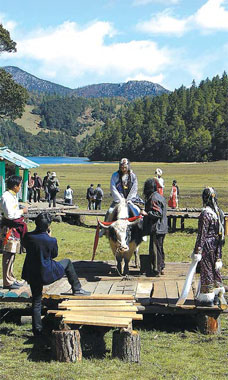It was 6 pm, tourists made a beeline for Tancheng Plaza, the largest open-air dance venue in Shangri-La, a well-known scenic spot in Yunnan province.

On reaching the plaza, they quickly formed a circle around a lamppost and did a dance known as Guozhuo in Tibetan and Guozhuang in Mandarin.
The happiest of all was Cering Zhoima, a woman tour guide.
"Thank God, I finally had a tour group to escort after so long," Cering Zhoima said.
She is employed by Qingnan Airlines Travel Service.
In recent days, Cering Zhoima has been kept busy escorting more than 20 domestic and overseas tour groups.
Shangri-La, capital of the Tibetan autonomous prefecture of Diqing, is situated close to Yunnan and Sichuan provinces.
It is famous for its breathtaking scenery described in James Hilton's novel Lost Horizon.
Diqing is largely dependent on tourism. It received 3.8 million tourists last year, of which 400,000 were foreigners.
Tourism, however, dropped markedly in most of the Tibetan-inhabited areas following last month's riots.
Due to safety concerns, travel services were advised to postpone organizing group tours to affected areas.
As a result, many group tours confirmed last year had to be cancelled, and Diqing in particular, suffered heavy losses.
April has always been a busy season for tourism in Diqing. Tourists from Thailand visit to worship Moirigkawagarbo, a snow-capped mountain, Cering Zhoima said.
Hozhiba, a Tibetan farmer-turned taxi driver, said Shangri-La was so quiet in late March and early this month, he hardly had a fare.
"Without customers, I had to depend on my savings," the 39-year-old said.
Overseas tourists are now back since the prefecture reopened to visitors on Thursday.
Statistics show Hutiao Gorge, a scenic site in Diqing, received 2,700 tourists on Friday, 300 were from overseas.
"People are coming back to Shangri-La. I have had more customers in the past few days and hope business will continue to get better," Hozhiba said.
(Xinhua News Agency April 22, 2008)